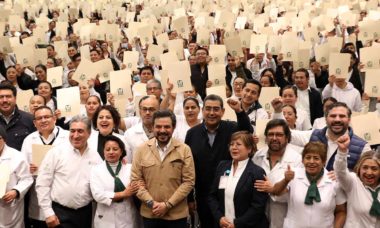En su intervención durante el seminario web “Prioridades relacionadas con el Cambio Climático en el Comercio y la Inversión”, organizado por el Gobierno de Bangladesh el 14 de febrero, la Directora General Ngozi Okonjo-Iweala expuso su opinión sobre cómo las prioridades climáticas podían abordarse a través de medidas comerciales que priorizasen las dificultades específicas que afrontan los países menos adelantados y los pequeños Estados insulares en desarrollo. La OMC puede desempeñar un papel clave en la prestación del apoyo que esos países necesitan para lograr una transición ecológica, declaró la DG. La intervención de la Directora General figura a continuación.
(de momento sólo en inglés)
Honourable Minister of Foreign Affairs, Minister Momen of Bangladesh, Excellencies, Distinguished Delegates, friends.
Let me congratulate the government of Bangladesh for working so hard to bring us together and let me take this opportunity to also thank Ambassador Rahman for his leadership on critical issues here at the WTO, including on LDC transition as well as on Climate Change.
I am delighted to be with you today to share my perspective on how climate priorities can be addressed through trade action through prioritizing the specific challenges faced by least developed countries (LDCs) and small island developing states (SIDS).
Some of the biggest threats to our economies and our societies come from environmental degradation – from climate change to biodiversity loss and the natural hazards that result. The climate crisis demands a multi-faceted response. At the heart of this response is our need to reduce poverty and enhance living standards while strengthening environmental sustainability. We must also drive positive environmental change into our recovery from the pandemic by building greener, more socially inclusive economies, and investing in the systems needed to identify and contain future disease outbreaks – such as early warning systems.
Recent crises have demonstrated that like in the ‘butterfly effect’ – small, imperceptible changes in part of the planet can have a profound impact on the lives and livelihoods of people everywhere on this planet.
In reflecting on the climate crisis and the global response to the pandemic, it is clear to me that, trade is part of the solution to the challenges we face, far more than it is part of the problem.
There are, inevitably, some downsides associated with trade: moving goods from one place to other has generally involved carbon emissions. But let’s not forget that trade also makes production more efficient, and this can reduce emissions.
Trade and open global markets have also helped lift over a billion people out of poverty in recent decades. But many poor people in rich countries, as well as poor countries, have not shared fully in the gains.
The answer to these problems does not lie in a rejection or reduction of trade. A new joint policy note produced by the WTO and the World Bank makes clear that trade will be critical in driving the post-pandemic recovery. A better answer to the real problems we see lies in better trade – a fairer and more equitable globalisation, one that brings marginalized people and countries into the economic mainstream, while helping us decouple human well-being from environmental impact.
Developing countries, and LDCs in particular, often have insufficient capacity to manage the risks and adapt to the environmental fallouts they are already experiencing. International mitigation policies and other measures to combat climate change could, if not careful calibrated with the needs and capacities of developing countries in mind, also impair the trade competitiveness of some developing countries. But I know that such policies are not incompatible with the growth and development needs of developing countries including SIDS and LDCs. In this regard, there are a number of ways in which trade can contribute to curbing climate change, while ensuring a just transition for those countries that did the least to contribute to the problem.
Climate change is already affecting trade and the economy: from changing rainfall patterns to extreme weather events leading to disruptions in supply chains. UNEP estimates annual adaptation costs in developing countries to reach $140 – 300 billion by 2030 and $280 – 500 billion by 2050. The increasing frequency of natural disasters also threatens to further weaken the ability of SIDS to trade competitively.
A WTO information brief on trade resilience in the face of natural disasters, published just before COP26 last year, confirms that natural disasters have a more severe long-term impact on small economies. This occurs as immediate impacts on such countries are disproportionally large and volatility of economic activities is higher. Developing countries, and particularly LDCs, face the challenge to enhance the climate-resilience of their trade-related infrastructure, improve digital connectivity and strengthen their policy frameworks as part of their efforts to mitigate the impact of natural disasters and adapt to climate change.
In our publication with the Global Centre for Adaptation we highlighted that trade is a mechanism for adaptation and resilience in the face of crop failure and natural disasters. Affected countries can bring in food and supplies necessary for reconstruction while domestic production remains impaired, allowing the economy to recover more quickly. One set of models published in Nature Climate Change estimates that climate change is on track to push 55 million people into undernourishment by 2050 because of localised impacts on food production. It found that greater trade integration could cut that number by as much as 64%, or 35 million people. Meanwhile, reducing trade in agricultural products would substantially increase the number of people likely to go hungry in the decades ahead.
On the mitigation side, developing countries must seek to use trade in support of their climate transition goals and build a diversified low-carbon economy. International competition and the emergence of a globally integrated solar photovoltaic (PV) supply chain has helped make solar the cheapest source of electricity generation in many parts of the world. Wind energy has benefited from similar trends. Trade and competition can play a similar role in lowering costs for future technologies such as advanced batteries and hydrogen electrolysers.
Climate-related trade policies must be framed with a just transition in mind, with transition times for developing countries to find carbon alternatives, but also the financing for them to leapfrog the dirty infrastructure stage and directly build sustainable alternatives.
There is an important link here with aid for trade: trade-related development assistance to build energy, transport, and telecommunications infrastructure totalled $25 billion in 2019. Going forward, aid for trade should seek to build climate-resilient infrastructure and foster climate-proof supply chains.
Climate finance is indeed essential for allowing transition to a low-carbon economy for developing countries. For the poorest and most vulnerable countries, LDCs and SIDS, finance for adaptation represents more than 40%, almost double the share for all developing countries. We need to demand optimized responses to the needs of developing and least developed countries. That is why the failure to mobile the 100 billion dollars a year of climate finance promised to developing countries is demotivating.
The Aid for Trade Initiative has an important role to play by mobilizing funding for critical supply-side infrastructure necessary for green transformation in developing countries and supporting the private sector to adapt to climate change. Between 2013 and 2018, over $65 billion of Aid for Trade was provided to projects with a climate objective, including renewable power generation, distribution, and energy conservation, as well as climate-friendly and climate-resilient infrastructure.
For instance, a project in Nigeria made possible through development assistance has installed solar lamps, solar panels and cook stoves that emit less carbon dioxide to the benefit of residents and small enterprises in remote communities.
However, aid for trade needs to be better targeted to address development concerns in line with LDCs’ nationally determined contributions. As I said earlier, the climate finance target as laid out in the COP16 accord has so far fallen short of the commitment to mobilize $100 billion per year by 2020. This commitment was reaffirmed last November at COP26. We must also encourage the private sector to participate in the investments necessary to address the climate crisis. For example, in 2019 private climate finance alone mobilised USD 14 billion, representing close to 18% of total climate finance. We therefore need to work together to explore the opportunities through aid for trade and other innovative financing mechanisms to address climate change issues in LDCs and explore opportunities for mutual leveraging of resources.
Beyond aid for trade, new international frameworks are necessary to ensure that countries at all levels of development take progressive steps towards enhanced environmental sustainability through trade. Therefore, support is needed for LDCs to assist them in participating in some on the ongoing discussions taking place at the intersection of trade and the environment. For example, WTO members are currently discussing several issues, such as the facilitation of trade in environmental goods and services, the transition to a circular economy, plastics pollution, sustainable supply chains, and environmentally harmful subsidies, including those related to fossil fuels. However, given the limited participation of LDCs, technical support must be made available to support the participation of LDCs in these discussions.
Indeed, lowering trade barriers to environmental goods and services would reduce the cost of renewable energy and lower the capital costs of building climate-resilient infrastructure. It will also result in economic diversification and job creation, particularly in services. Services jobs related to renewables are often supplied locally and carried out by women. A growing number of jobs, especially in Africa, are being created in off-grid decentralized renewables, which also boosts employment in other sectors such as agro‑processing, health care, communications, and local commerce.
WTO has a lot to contribute to this respect. Environmental goods and services are a focus of the Trade and Environmental Sustainability Structured Discussions (TESSD), an initiative that brings together 71 WTO members, amongst which many developing countries. Participants have defined a road map for work in 2022, and set up exchanges with business, civil society, and academic experts.
The Informal Dialogue on Plastics Pollution and Environmentally Sustainable Plastics Trade (IDP) is another initiative seeking to foster coordinated action to address the environmental, health and economic costs of plastics pollution. The Informal Dialogue has gathered the support and participation of developed, developing and LDC members alike, with a particular attention to SIDS and has stressed the need to strengthen technical assistance for vulnerable economies.
In closing it is important I address efforts underway to institute carbon taxation schemes. Effective carbon pricing is increasingly considered a key market mechanism to support low carbon just transition. And the LDCs must be part of the discussion.
International cooperation can help ensure that efforts to put a price on carbon do not lead to avoidable business costs and trade frictions or place disproportionate burdens on poor countries. Fragmentation raises compliance costs and uncertainty for the private sector – and weighs heaviest on small businesses. In addition, some developed countries are considering «border tax adjustment measures», intended to equalize carbon costs across foreign and domestic producers.
However, many developing countries fear such measures could in practice be misused as a pretext for protectionism against their exports. This could weaken global cooperation on climate change when we need to strengthen it. In my view, the optimal solution would be a shared global carbon price approach aligned with the Paris Agreement and its principles, though politically we are not there yet.
In the meantime, we must work closely with other international organisations, such as the IMF, the World Bank, the OECD, and others, and work on common approaches to carbon pricing, ensuring that measures are not adopted in a discriminatory manner and that the needs of developing countries and LDCs are addressed to enable a just transition.
Ultimately, this discussion is about people and planet. It is about ensuring that environmental sustainability is integrated into how we trade and what we trade. Let me therefore thank the Government of Bangladesh for this initiative, particularly in its current leadership role of the Climate Vulnerability Forum for the continued interest in advocating for strengthening the multilateral response to climate change.
In sum, LDCs are in need of support for a green transition and the WTO can play a key role in that regard. LDCs should not be left behind.












